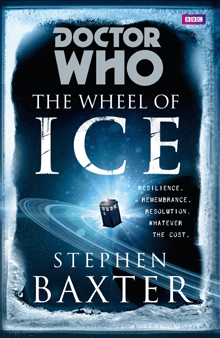
Notwithstanding Gareth Robert’s Shada, this is the first past Doctor tale published since 2005. Using the popular line-up of the Second Doctor, Jamie and Zoe, author Steven Baxter has remained true to the memories of his youth; he would have turned eleven during Season 6.
The story begins with the TARDIS unexpectedly materialising inside one of the rings of Saturn as the result of an automatic procedure when it detects a hole in time. While the time machine refuses to budge, the crew are rescued and towed from the rings by a teenage girl and a bizarrely Glaswegian space borne AI robot called MMAC,
They are recovered to the nearby Mnemosyene Cincture, a mining station surrounding one of Saturn’s minor moons. Colloquially known as the titular ‘Wheel of Ice’, the outpost is constructed from a mixture of ice bubbles and ancient salvaged space debris, and home to a colony of people working to retrieve the rare element Bernalium from the icy moon below.
A fantastic concept, this is a world of messy, frontier space mining that is far more engaging than the show’s regular diet of sterile space stations. Amusingly, at one point the Doctor mentions that the cramped conditions remind him of a caravan holiday he once took in Wales. There’s a story we’d like to see!
 As they tour the station, the Doctor and friends discover there has been a spate of sabotage and are promptly accused. The running of the colony is a political hot potato, with the hard working mayor balancing the needs of the people against the drive to produce for the Bootstrap Mining Consortium.
As they tour the station, the Doctor and friends discover there has been a spate of sabotage and are promptly accused. The running of the colony is a political hot potato, with the hard working mayor balancing the needs of the people against the drive to produce for the Bootstrap Mining Consortium.
This is business-driven space, with corporate priorities threatening to ride roughshod over personal liberties, with a sense of the Alien films’ Weyland-Yutani Corporation at play.
Baxter captures the interplay between Jamie, Zoe and the Doctor well with authentic dialogue and a real feel for the characters. Good use is made of Zoe’s advanced science skills and perfect recall, as well as her discomfort at being around what she perceives as relatively primitive space equipment.
Jamie, for his part, gets to be a man of action and finds a role within the younger elements of the community despite being totally out of his depth around the technology. One reservation is that Jamie appears to be very Scottish indeed here, with his dialect making it quite difficult to read, though that’s nothing compared to the broad Glaswegian of MMAC.
 The primary threat comes from an alien intelligence, and is shared with the reader long before the characters get a sense of what they are facing. Its objective and elements of the back story are drip fed through a series of interludes which build up as an alternative perspective.
The primary threat comes from an alien intelligence, and is shared with the reader long before the characters get a sense of what they are facing. Its objective and elements of the back story are drip fed through a series of interludes which build up as an alternative perspective.
It’s a clever narrative trick and helps to keep us one step ahead of the Doctor, as well as introducing the fantastic concept of an allohistorical lure; that is an object sent back in time to tweak history towards a certain event. Of course, as always with humanity, threats also come from within although in this case the villain has a tendency to be a little arch and unconvincing at times.
The novel is shot through with references to vintage Doctor Who stories, from the Mars Probes of The Ambassadors of Death to UNIT and the T-Mat. Baxter clearly knows his Who inside out and while some of the references are well worked into the script, others are just blatant name checks for the fun of it such as Li Hsen Chang and Black Orchid.
Attracting an author with the profile of Stephen Baxter is another coup for the range, as it was with Michael Moorcock and Jenny Colgan. The Wheel of Ice is an adventure that the television series could never hope to stage today, let alone in the late 1960s.
With visits to some of the other planetary bodies, ice volcanoes and hydrogen lakes, it has remarkable scope and ambition, not only in its futuristic setting but with the elements of harder science mixed into the fiction. Despite all this, what really attracts here is the excellent rendition of the three central characters.
![]()
Published on Thursday 16th August July 2012 by BBC Books.
What did you think of the book? Let us know below…

